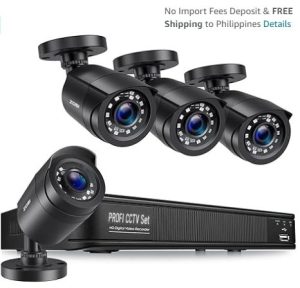Understanding CCTV Camera Installation: A Step-by-Step Tutorial

CCTV (Closed-Circuit Television) cameras serve as crucial tools in modern surveillance, transmitting signals to specific places and aiding in crime prevention by recording evidence useful in courts. With types including Digital Video Recording Systems, Network Video Recording Systems, and IP Cameras, understanding CCTV camera installation is essential.
Our guide delves into selecting the right CCTV system and provides a step-by-step tutorial on installing security cameras effectively. By optimizing your CCTV camera placement and learning to maintain your system, you’ll ensure your surveillance setup acts as a strong deterrent to crime.
Choosing the Right CCTV Camera System
Choosing the right CCTV camera system involves considering several factors to ensure optimal security coverage and functionality. Here’s a breakdown of key considerations:
-
- Budget and Costs: A four-camera CCTV system can range from ₱3,500 to ₱20.000, with single cameras (IP cameras) priced between ₱500 to ₱2500. Balancing your budget with the features you need is crucial.
- Camera Types and Their Uses:
- Dome Cameras: Best for indoor use, offering 360-degree coverage. They’re hard to tamper with due to their dome shape
- Bullet Cameras: Ideal for outdoor use, providing extended range visibility. They serve as a visible deterrent.
- PTZ Cameras: Allow for remote control (pan, tilt, zoom), suitable for monitoring large areas.
- Thermal Cameras: Utilize heat signatures, perfect for low-light conditions.
- IP Cameras: Digital cameras that transmit data over an IP network for remote viewing and management.
- Key Features to Consider:
- Resolution: For general surveillance, 2MP to 4MP cameras are usually sufficient. Critical areas may benefit from higher resolutions (4MP to 8MP or more).
- Night Vision: Cameras with infrared (IR) LEDs are essential for capturing clear images in low-light or dark conditions.
- Field of View: Wide-angle lenses are suitable for capturing larger areas, while narrow-angle lenses focus on specific points.
- Connectivity: Modern CCTV systems offer wired, wireless, and Power over Ethernet (PoE) options.
- Storage: Decide between using Digital Video Recorders (DVRs), Network Video Recorders (NVRs), or cloud-based storage solutions.
- Advanced Features: Look for cameras with motion detection, facial recognition, and object tracking. AI integration can automate surveillance tasks.
Selecting the appropriate CCTV camera system requires careful consideration of these factors to ensure comprehensive coverage and effective surveillance.

Step-by-Step Guide to Install Your CCTV System
-
Planning and Preparation
- Identify Installation Areas: Decide on the locations for camera placement, considering coverage angles and indoor/outdoor requirements.
- Gather Equipment: Ensure you have all necessary tools and materials, including CCTV cameras, DVR/NVR, cables, power supply, and mounting hardware.
-
Installation Process
- Mounting Cameras: Secure cameras using appropriate brackets, ensuring a clear view of monitored areas.
- Wiring: Arrange and connect coaxial cables for video transmission and power cables for electricity, adhering to correct polarity (red for positive, blue for negative).
Connecting to DVR/NVR: Run cables from cameras to the DVR/NVR, following manufacturer’s instructions for power, video, and data connections.
-
System Configuration and Testing
- Powering Up: Connect the power supply to the DVR/NVR and cameras, checking all connections are secure.
Configuring DVR/NVR: Set recording parameters, motion detection settings, and configure remote access if desired.
Testing: Verify cameras function correctly with clear video feed. Adjust camera angles and settings for optimal performance.
Monitoring and Maintenance: Regularly check the system for proper function and perform necessary maintenance tasks.
- Powering Up: Connect the power supply to the DVR/NVR and cameras, checking all connections are secure.
This guide outlines the critical steps in installing security cameras, from planning to testing, ensuring a functional CCTV system.
Optimizing Your CCTV Camera Placement
Optimizing the placement of CCTV cameras is crucial for enhancing security measures. Consider the following key points for effective camera placement:
-
-
-
Critical and High-Traffic Areas:
-
- Place cameras at all exterior doors and windows to deter crime and capture potential intruders.
- Ensure coverage of points of sale, employee-only areas, and common spaces like living rooms and master bedrooms for both security and operational efficiency.
- Install cameras to monitor parking lots, loading docks, and back entrances for comprehensive surveillance of vulnerable areas.
-
Optimal Camera Height and Positioning:
- Mount cameras at a height of 8 to 10 feet off the ground to avoid vandalism while ensuring a wide coverage area.
- Position cameras in locations that are not easily accessible or tamper-proof to intruders, such as high up on walls or ceilings.
- Angle cameras correctly, placing them a foot or two next to doors or windows for clear entry point surveillance.
-
Lighting and Environmental Considerations:
- Select appropriate lighting for cameras, especially for nighttime monitoring, to enhance image quality and identification potential.
- For outdoor cameras, ensure a high IP rating to withstand harsh weather conditions and place lighting higher than the camera to avoid glare.
- Regularly inspect and adjust the placement and settings of cameras to adapt to environmental changes and maintain optimal surveillanc.
-
-
By adhering to these guidelines, you can maximize the effectiveness of your CCTV camera installation, ensuring a secure and well-monitored environment.
Maintaining and Troubleshooting Your CCTV System
To ensure the longevity and effectiveness of your CCTV camera installation, regular maintenance and prompt troubleshooting are essential. Here’s how to keep your system in top condition:
Regular Maintenance Checklist:
- Cable and Power Supply Inspection: Use high-quality coaxial cables to minimize signal loss [14]. Regularly check cables for damage and ensure all connectors are secure. Verify the power supply unit has sufficient amperage for all cameras.
- Camera Care: Inspect cameras for physical damage and clean lenses with a soft cloth to ensure clear imaging. Dust off CCTV components and clean cooling fans to prevent overheating.
- System Health: Check recorders for overheating signs, update storage capacity, and clean DVR/NVR interiors to avoid dust accumulation. Regularly back up data to a secure location.
Troubleshooting Common Issues:
- Signal and Image Quality: If experiencing no image or poor quality, check for power failure, cable, camera, or monitor damage. Adjust camera and monitor settings or use a higher quality cable for better image quality.
- Recording Problems: For issues with recording or playback, inspect recorder storage, settings, and compatibility. Ensure recorder is not failing.
Pro Tips:
- Firmware and Software Updates: Keep your CCTV system firmware up-to-date to enhance functionality and security.
- Expert Assistance: If troubleshooting does not resolve the issue, seek help from a professional to avoid further damage.
FAQs
Q: What are the steps for installing a CCTV camera?
A: To install an outdoor CCTV camera, you should use wire mouldings to secure the cables and protect them from tampering. Connect the network cable to your internet router. If you are using IP cameras, you will need a Cat 5 or Cat 6 cable. For analogue HD cameras, a BNC cable and a DC pin connector are required. Finally, connect each camera to the DVR (Digital Video Recorder) or NVR (Network Video Recorder).
Q: What should I consider before installing a CCTV camera at my home?
A: Before installing CCTV cameras, consider the following six factors:
- Coverage: Assess the size of your home and determine which areas you wish to monitor. Decide whether you want the cameras to be a visual deterrent or if you prefer to keep them hidden.
- Types of Cameras: Choose the right type of camera that suits your needs.
- Technical Aspects: Understand the technical requirements such as resolution, storage, and connectivity.
- Legal Aspects: Be aware of legal regulations regarding privacy and surveillance.
- Permissions: Check if you need any permissions or consent from authorities or neighbors.
- Budget: Plan your budget for purchasing and maintaining the CCTV system.
Q: How do CCTV installations function?
A: Traditional hard-wired CCTV cameras are optimal for permanent setups in areas that are not easily accessible or prone to tampering. They function by connecting to a network via cables, which transmit the video footage to a monitor or digital recording system. However, it’s important to note that the distance from the camera to the monitor or recording system can sometimes be a limiting factor.
Q: What are the prerequisites for setting up a CCTV system?
A: The key requirements for setting up a CCTV system include proper camera placement, a robust network infrastructure, reliable power supply, and the right choice of camera type. Additionally, you should consider the best locations for camera installation and the direction they should face, accounting for potential weather and lighting conditions. Regular maintenance is also essential to ensure the system operates effectively.
Related Links:
- Youtube Video: CCTV Camera Installation (Practical Guide)
- Caught on Camera: 10 Common CCTV Problems and How to Fix Them
- Quora: What should I consider when choosing a CCTV security camera for my home or business?
- DTiQ: Camera placement for surveillance and security
- Amazon: Free shipping to the Philippines
